Indigenous Institute for Health and Healing paves the way to health care equity
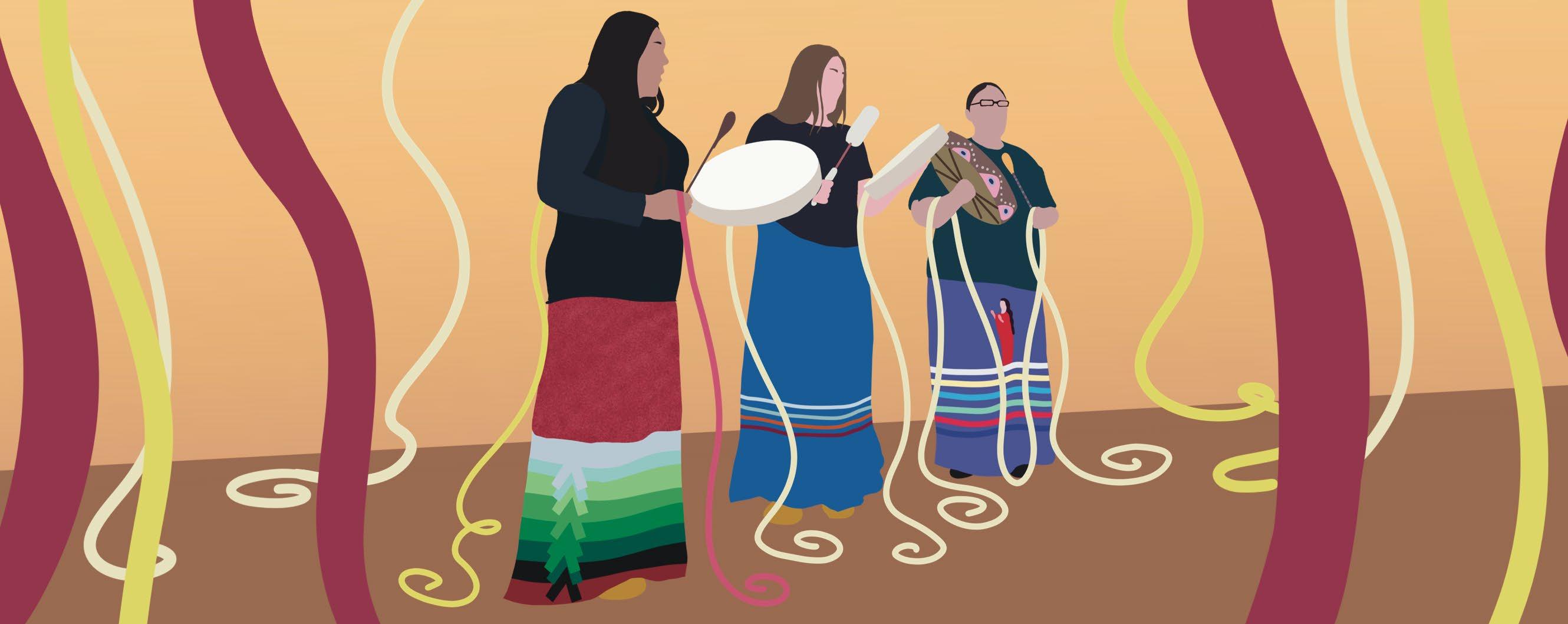
Ongomiizwin is an Anishinaabe word that means “clearing a path for generations to come.”
It is also the name of the U of M’s Indigenous Institute of Health and Healing. Founded in 2017, Ongomiizwin combines three sections of the Max Rady college of medicine: the Manitoba First Nations Centre for Aboriginal Health Research, the Centre for Aboriginal Health Education, and the J.A. Hildes Northern Medical Unit.
Ongomiizwin is “the bringing together of some longstanding units,” said Melanie MacKinnon, head of the institution. “We have that longstanding history and foundation to build upon.”
The institution aims “to support Indigenous communities in the full expression of their self-determination.”
MacKinnon noted that Ongomiizwin was created following calls to action made by the Truth and Reconciliation Commission of Canada. These calls to action included respecting traditional Indigenous knowledge and healing practices, “removing barriers to health professional
and anti-racism.”
“Our work in anti-Indigenous racism and cultural safety is nationally recognized,” MacKinnon said. “Our work in clinical outreach and medical services is also nationally recognized.”
She noted that Ongomiizwin is unique in its work as an academic institution supporting northern health and access to clinical services. Their work incorporates both health and education.
“The work is generational work, as it’s been generations of residential school experiences for survivors and ancestors,” MacKinnon said. “We understand that it’s also collective work and responsibility and it’s not the responsibly of solely Indigenous health leaders to respond to the needs of our community.”
“That is a systems approach,” she explained.
In a report titled “Guiding Voices,” Ongomiizwin’s Indigenous advisory council discussed goals for the platform.
They highlighted that Indigenous people in Canada are disproportionately
impacted by illness, injury and death. Yet despite racial disparities in health care being well-established, the treatment provided by healthcare systems to racialized people is not regularly measured. There is no system to collect racial or ethnic identifiers during a patient’s healthcare encounter.
To combat this, the report suggested “a focused effort in collecting and monitoring healthcare system data in order to identify where disparities exist.”
The report identified health inequity, health disparity and racial health-care disparity as three important concepts that relate to the quality of health care experienced by Indigenous people.
They also noted that many health-care quality improvement measures widen gaps in health-care equity due to institutional racism. Improvements in health care are often focused on advantaged members of the population, rather than marginalized groups.
“A focus on health inequities is critical in the desire to achieve a health-care system that provides equitable high quality healthcare for every person,” the report stated.
In 2022, Ongomiizwin published the “Indigenous Healthcare Quality Framework” in partnership with Indigenous Healthcare Quality Leads and the George & Fay Yee Centre for Healthcare Innovation.
The framework highlighted the dimensions required to provide high-quality health care to Indigenous people. Patients and their families should feel validated, trusted and respected. Providers should be nonjudgemental, compassionate, attentive and culturally safe. The overall health-care system, the framework emphasizes, should be accessible, collaborative, flexible and approachable.
The framework is rooted in Joyce’s Principle, a call to guarantee Indigenous people equitable and non-discriminatory access to social and health-care services. The principle takes its name after Joyce Echaquan, an Indigenous woman whose experience with racism in health care contributed to her death. Echaquan was at the hospital when she raised concerns of heart palpitations. The medical staff made the unfounded assumption that she was suffering from withdrawal
and failed to provide her with appropriate treatment. A coroner’s inquiry states that this treatment by health-care workers contributed to her death.
Echaquan’s coroner, Gehane Kamel, acknowledged the role racism played in her death, stating that she believed Echaquan would be alive if she were white.
Following the inquiry into her death, Kamel told Echaquan’s family that “a small revolution of reconciliation” had begun, and that her death would not be in vain.
The role of institutions like Ongomiizwin is to foster efforts toward this revolution.
“Our role is helping to bridge and facilitate that collective work,” MacKinnon said, “whether that be through cultural safety, anti-Indigenous racism [...] exemplary clinical services, or role modelling what system change and modernized programs would look like.”
“I think the university community should be proud of the work of the institution and its national recognition and standing and how we have designed ourselves to be reflective of the communities that we serve.”
News 3
Definition proposition
UMSU considers anti-Palestinian racism definition
Editorial 6
Spring has sprung
The sun has come out of hiding, it’s time to celebrate
Mind the gap
Aaron Bushnell’s selfimmolation reframes mental illness
Arts & Culture 10
River reclamation
Rise, Red River playing at PTE and Théâtre Cercle Molière
Sports 19
Bisons bag bronze
UM women’s volleyball comes third at U Sports championships
110

EDITOR-IN-CHIEF Gillian Brown editor@themanitoban.com
BUSINESS MANAGER Alice Teufack accounts@themanitoban.com
ADVERTISING CO-ORDINATOR Diego Castro ads@themanitoban.com
EDITORIAL
MANAGING EDITOR vacant me@themanitoban.com
COPY EDITOR Simon Pensato copy@themanitoban.com
COPY ASSOCIATE Paula Samaniego-Ayllon
NEWS EDITOR Sarah Cohen news@themanitoban.com
NEWS EDITOR Colton McKillop news@themanitoban.com
RESEARCH & TECHNOLOGY EDITOR Elah Ajene research@themanitoban.com
COMMENT EDITOR Jessie Krahn comment@themanitoban.com
ARTS & CULTURE EDITOR Jacob Davis arts@themanitoban.com
SPORTS EDITOR Joshua Brandt sports@themanitoban.com
DESIGN
DESIGN EDITOR Taeran An design@themanitoban.com
DESIGN ASSOCIATE Deveney Jarrow
GRAPHICS EDITOR Teegan Gillich graphics@themanitoban.com
GRAPHICS ASSOCIATE Dallin Chicoine
AUDIO AND VIDEO
AUDIO EDITOR Harmatpreet Brar audio@themanitoban.com
PHOTO EDITOR Ebunoluwa Akinbo photo@themanitoban.com
PHOTO ASSOCIATE Matthew Merkel
VIDEO EDITOR vacant video@themanitoban.com
SOCIAL MEDIA EDITOR Violet Baker social@themanitoban.com
REPORTERS
NEWS Alicia Rose
NEWS Kyra Campbell
RESEARCH & TECHNOLOGY Rhea Bhalla
COMMENT Braden Bristow
COMMENT Lakshmisree Shaji
ARTS & CULTURE Kelsey Chin
ARTS & CULTURE Alison Holliday
SPORTS Quinn Mayhew
VOLUNTEERS
VOLUNTEER STAFF
Bahareh Rashidi, Christina Tran, Romin Cheema Adam Johnston, Michele Melendez
VOLUNTEER
Alison Moule, Octavius Kahiya, Kenny Ingram interested in volunteering? email me@themanitoban.com today!
109 HELEN GLASS BUILDING
UNIVERSITY OF MANITOBA
WINNIPEG, MB
204. 474. 6535
The Manitoban is the official student newspaper of the University of Manitoba. It is published monthly during the summer and each week of regular classes during the academic year by the Manitoban Newspaper Publications Corporation.
The Manitoban is an independent and democratic student organization, open to participation from all students. It exists to serve its readers as students and citizens.
The Manitoban is a member of the Canadian University Press, and our journalistic standards can be found on the Manitoban’s website.
The newspaper’s primary mandate is to report fairly and objectively on issues and events of importance and interest to the students of the University of Manitoba, to provide an open forum for the free expression and exchange of opinions and ideas and to stimulate meaningful debate on issues that affect or would otherwise be of interest to the student body and/ or society in general. The Manitoban serves as a training ground for students interested in any aspect of journalism.
Students and other interested parties are invited to contribute to any section of the newspaper. Please contact the appropriate editor for submission guidelines.
The Manitoban reserves the right to edit all submissions and will not publish any material deemed by its Editorial Board to be discriminatory, racist, sexist, homophobic or transphobic, ableist or libellous.
Opinions expressed in letters and articles are solely those of the authors. Editorials in the Manitoban are signed and represent the opinions of the writer(s), not necessarily those of the Manitoban staff, Editorial Board or the publisher.
A “volunteer staff” member is defined as a person who has had three volunteer articles, photographs or pieces of art of reasonable length and/ or substance published in the current publishing year of the Manitoban.
Any individual who qualifies as a volunteer staff member must be voted in by a majority vote at a Manitoban editorial board meeting. Elected representatives and non-students may be excluded from holding votes as volunteer staff members in accordance with the Manitoban Constitution.
All contents are ©2024 and may not be reprinted without the express written permission of the Editor-in-Chief.
CORRECTION: Bisons perform at U-Sports championships, featuring track and field, swimming
In its March 13 issue, the Manitoban incorrectly stated that Jordan Soufi tied in the 60 metre sprint, that Dawson Mann won gold in the 600 metre race and that Graham Hutchison-Campbell placed third in the weight throw. In the competitions, Soufi won the 60 metre sprint with a time of 6.69 seconds, Tristan Allen won gold in the 600 metre race, and Mann finished third. Joshua Suelzle finished third in the weight throw.







Anti-Palestinian racism definition proposed to UMSU
Student proposes definition be added to UMSU’s equitable campus statements
alicia rose, staffAmotion to adopt the Canadian Arab Lawyers’ Association’s (CALA) definition of anti-Palestinian racism was brought forward during the most recent UMSU board meeting on March 14. The motion was referred to the governance committee to be voted on at a later date.
The motion was brought forward by Roleen Alarab, a Palestinian student at the U of M who provides external communications for Students for Justice in Palestine. The motion proposes that the definition be included in section seven of UMSU’s position statement book.
The CALA definition states that “anti-Palestinian racism is a form of anti-Arab racism that silences, excludes, erases, stereotypes, defames or dehumanizes Palestinians.”
Alarab said the motion “seeks justice and recognition” for Palestinian and Muslim students at the university.
“This motion aims to shed light on the systemic challen-
ges we face to pave the way for a more inclusive and understanding campus environment,” she said.
She said the motion highlights “the collective struggle of Palestinian Muslim students on campus.”
The CALA definition lists denial of the Nakba — an Arabic term which means “catastrophe” and refers to the 1948 forced displacement of 700,000 Palestinians amid the creation of the state of Israel — defending violence against Palestinians, denial of Palestinians’ connection and rights to “historic Palestine,” excluding Palestinian perspectives and claiming that Palestinians and their supporters are “inherently antisemitic” or sympathetic to terrorism as examples of anti-Palestinian racism.
Alarab said that UMSU’s potential recognition of the CALA definition would be a “profound affirmation” of Palestinians students’ experiences and would demonstrate the university’s commit-

ment to opposing “all forms of racism.”
“This is about more than just a policy or definition, it’s about sending a message that the university is a place where every student’s identity and history are acknowledged and respected,” she said.
Alarab said approval of the CALA definition would demonstrate recognition of the “unique challenges and forms of discrimination” that Palestinians face. She said she hoped it would help people see their struggles “not as
abstract issues, but as lived realities that impact our daily life and academic experiences.”
Alarab said an “inclusive campus environment” to her means “an academic and social setting that actively works against the marginalization and exclusion of Palestinian voices.”
“It’s about knowing that the university is a place where identity is not just tolerated, but respected and embraced,” said Alarab.
She said the CALA def-
inition provides a “formal framework” of language and “institutional backing” for Palestinian students to advocate for their rights and seek support. She said adopting it would open up opportunities for dialogue and education between students .
“For me, this is an opportunity to share my perspective, educate peers about the Palestinian narrative, and dismantle stereotypes and misconceptions,” she said.
International student health coverage timeline unclear
Commitment
Kyra Campbell, staff
to re-introduction of program included in minister’s mandate letter
International student Garv Bhasin says he and other international students would benefit from provincial health insurance.
“There should be some plans,” said Bhasin.
With another academic year coming to a close, the timeline of the reinstation of international students to the provincial health care system remains unclear, despite promises by the Manitoba NDP.
Both Bhasin and fellow international student Nehemiah Kayode have medical needs covered under UMSU’s StudentCare and both agree that they would like to see the re-introduction of the provincial program.
The Manitoba International Student Health Plan currently covers medical needs including access to physicians and hospital services, and costs $1,032 annually. The supplemental UMSU health and dental plan, which costs an additional $373 annually, covers needs including access to psychologists and vaccinations.
During the provincial election period, the Manitoba
NDP reiterated its commitment to restoring health care coverage for international students. The commitment was included in Minister of Advanced Education and Training Renée Cable’s mandate letter when she assumed the role in Oct. 2023.
Minister of Health, Seniors and Long-Term Care Uzoma Asagwara and Cable declined requests for an interview. Press secretary Naline Rampersad provided an email statement from both.
“Our government has committed to restoring health coverage for international students,” the statement read. It also affirmed that minster Asagwara is “actively working with [their] colleague minister Cable to address this issue.”
UMSU vice president advocacy Liam Pittman, whose term ends in just over a month, said UMSU has brought up the issue of international student health care “in every meeting at the provincial advocacy level.” However, a timeline for implementation was not confirmed in any of those meetings.
“If I had the stroke of the pen, [international students] would be back on it tomor-
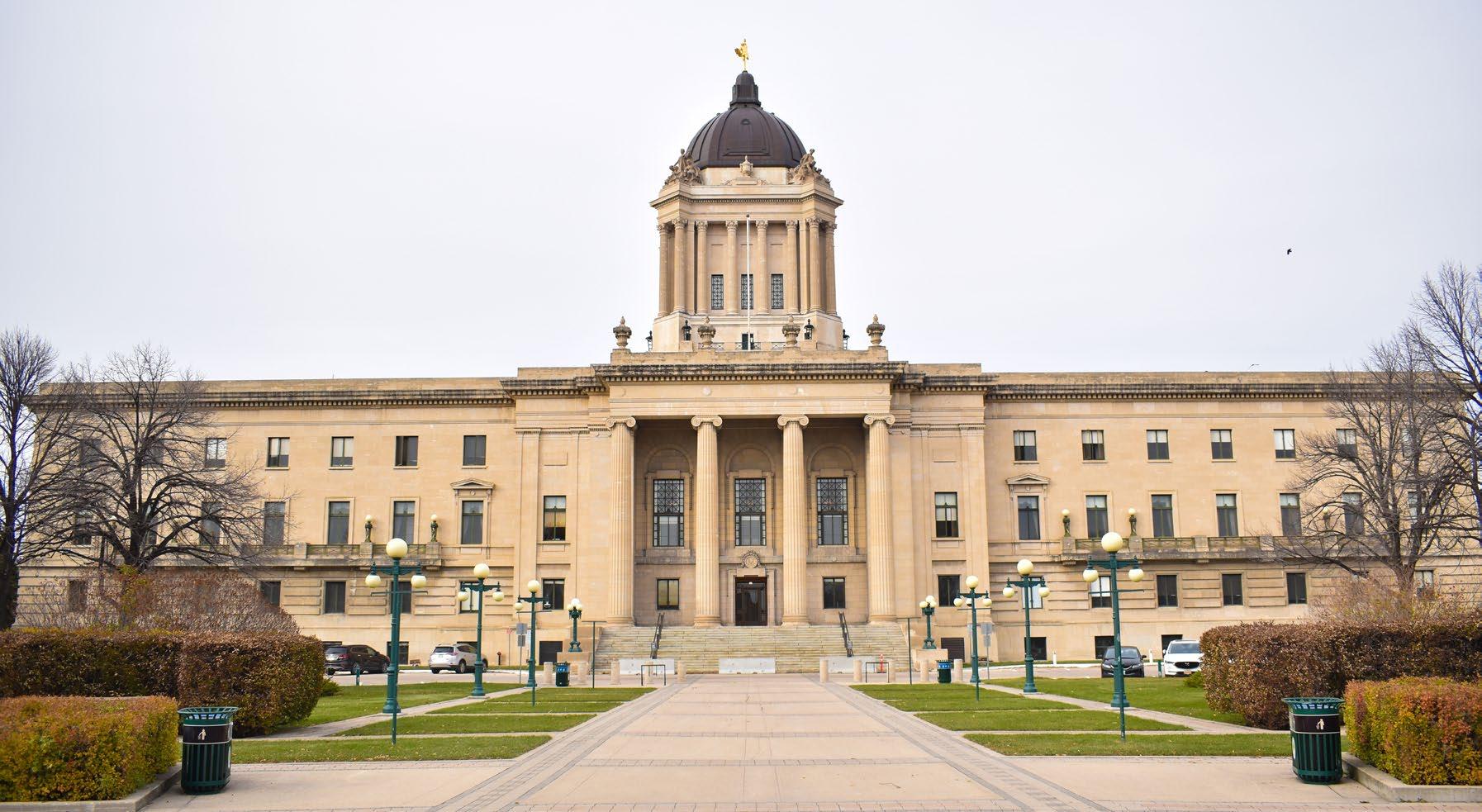
row,” he said.
UMSU has asked for the implementation to occur “as quickly as possible.”
UMSU international students’ representative Andrea Nguyen said reinstating the program is something that UMSU continues to work on, but that there has not been “much progress.”
“Honestly, it has been a bit challenging,” she said.
Nguyen said the lower cost of living in Manitoba compared with other areas of Can-
ada draws many international students to study in the province, but that they are unaware of the health care costs compared to other provinces, like Saskatchewan and Alberta, that cover international students under their provincial health care systems.
Nguyen said she is focusing on providing international students with information on how to use their health care plan and other affordability issues affecting international students.
Nguyen and other UMSU board members say they are prioritizing making other aspects of living easier through programs including providing hygiene products through the food bank and making sure that students know about financial aid opportunities.
At the time of publication, the provincial government has yet to make any announcement of health care changes for international students in the province.
2024-25 UMSU budget prepares for deficit
Expected revenue from VW Social Club down over $50,000
Sarah Cohen, staffThe UMSU budget for the 2024-25 fiscal year was presented March 14 at the board of directors (BoD) meeting.
Vice president finance and operations (VPFO) Vaibhav Varma presented the budget in order for approval at the March 28 meeting.
The fiscal year runs from May 1 to April 30, and the budget is written in projections, or estimates of what numbers will be, Varma said.
The budget projects a revenue of $2,549,149 from the five UMSU-owned businesses, collected fees and commissions and operational revenue. The total budgeted expenses is $2,628,532, which ranges from executive and administrative salaries to operational expenses.
This leaves the union with a projected overall deficit of $79,384 for the 2024-25 year. This contrasts with the 202324 budget, which predicted a total surplus of $38,363.
Varma said the revenue that last year’s budget planners were hoping for was “dramatically too high.” He said keeping the budget “modest” allows space for businesses to generate a greater income.
VPFO-elect Carolyn Wang said she thinks “it’s better to keep everything conservative.” Otherwise, it “just causes disappointment.”
Student fees make up over 70 per cent of UMSU’s projected revenue. The number is created from the consumer price index — or number of students the university projects will enroll the following year — and the amount each undergraduate student pays in UMSU fees. The estimated number for the 2024-25 fiscal year is $1,849,595.
One of Wang’s campaign promises was to, if elected, allow student to opt out of certain UMSU fees. When asked if this goal would be a healthy financial choice for the union, she said it would vary on a “case-by-case basis” and that students who need financial assistance for paying student fees are her “utmost priority.”
Wang said the projected deficit could be helped if the union “cut[s] back on some expenses,” such as holding events at less expensive venues.
Of the five businesses
UMSU owns — GPA’s, IQ’s, Degrees, UMCycle and VW Social Club — VW’s is projected to have the largest rev-
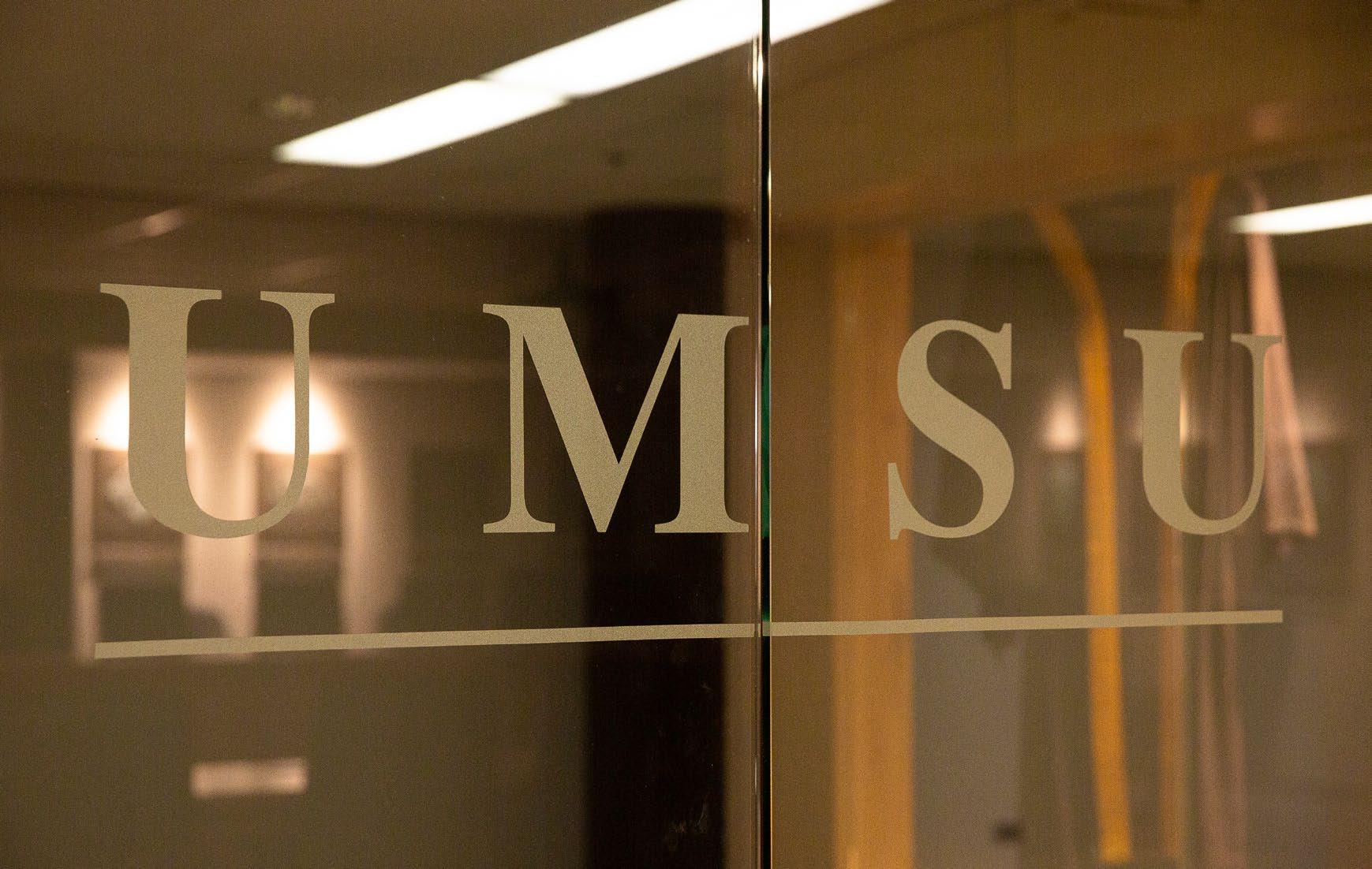
enue decrease of $56,692 from $67,098 to $10,406.
Varma said this “drastic change” was in part due to the number for this fiscal year’s similarity to campus life preCOVID-19, while the “drinking culture on campus has decreased dramatically” in the current student body and the cost of labour has risen.
Wang said she thinks the current operating hours of VWs “are not very popular with students.” To attempt to
fix this, Wang said she would revise the hours, accommodate students’ dietary needs and curate menus to what they want to see.
She reiterated the importance for her that the union — which is classified as a nonprofit organization — make a profit off its businesses. Varma said that any profit the union incurs in a given year will be placed in a retainer account.
Wang knows that businesses lose money if people
do not buy their products. She said the key to encouraging profit is to “drive up demand.” That way, UMSU businesses can lower prices and still make a profit.
The budget will be voted on at the March 28 UMSU board meeting. Students can reach out to Varma at vpfo@umsu. ca to ask questions related to the budget.

Research & Technology
U of M professor investigates soil health in British Columbia Project delves
Elah Ajene, staffIinto agricultural productivity and energy infrastructure
n Canada, British Colum-
bia is the second largest producer of natural gas. However, the intersection of energy infrastructure and agricultural lands poses a unique set of challenges for its farmers.
Francis Zvomuya is a professor in the U of M’s department of soil science in the faculty of agricultural and food sciences.
“There’s a lot of production of oil there,” he said. “It’s coexisting with agriculture.”
While vital for energy production, the installation of pipelines for natural gas extraction often disrupts agricultural fields and affects soil health, Zvomuya explained. This disruption can lead to decreased crop yields and productivity, impacting farmers’ livelihoods.
Prompted by farmers’ concerns and the provincial government’s interest, Zvomuya embarked on a research project to investigate the longterm impacts of pipeline installation on soil health and crop yields.
Zvomuya’s study extends beyond the regular assessments conducted post-reclamation. Instead of prioritizing plant counts and heights as proxies for productivity, his research scrutinizes actual crop yields and soil quality — measuring aspects such as microbial populations, nutrient cycles and soil physical processes impacted by pipeline construction. Additionally, the study probes into the potential influence of pipeline infrastructure on soil temperature, moisture dynamics and root development.
Zvomuya emphasized that soil health is crucial for agriculture.
“Just like us humans, it’ll take time for the soil and the land to heal after that damage,” he said.
For the project, they selected pipeline corridors ranging from three to four years post-reclamation, as well as older pipelines dating back 12 to 13 years, to assess productivity and yield.

enue losses following pipeline installations are validated. Moreover, certain soil properties exhibit slow recovery
of pipelines and also look at different scenarios,” Zvomuya said, regarding the next steps for the project.
“Just like us humans, it’ll take time for the soil and the land to heal”
— Francis Zvomuya, U of M professor in the department of soil science
“We took advantage of the fact that we have pipelines of different ages within that region,” Zvomuya said.
The preliminary findings, though not entirely surprising, reveal notable trends.
Farmers’ concerns regarding reduced yields and rev-
rates, indicating a protracted healing process for disturbed lands. While some indicators show signs of improvement over time, the pace falls short of expectations.
“We have proposed that we want to look at a large number
As Zvomuya explains, his motivation for focusing on soil science stems from his diverse background and extensive experience in the field. Beginning with a bachelor’s degree in agriculture specializing in soil science in Zimbabwe, he continued his studies through a master’s degree in England and a PhD in Minnesota.
Zvomuya later worked in land
reclamation in Alberta.
“That’s where I first got exposed to land reclamation, because of the energy industry there,” he said.
Aside from land reclamation, Zvomuya’s expertise extends to studying contaminants such as lead, as demonstrated by his work in investigating lead contamination in home gardens and city parks. Additionally, he is involved in researching nutrient recovery from food cycles, particularly in wastewater.
“A lot of my research focuses on environmental impacts and how we mitigate those,” he said.
Looking ahead, Zvomuya
emphasized the importance of addressing issues to minimize their impact on agricultural land and the economy, reflecting on the role of scientists.
“What we try and do is to find ways of mitigating those problems,” he said. “So we can say, ‘okay, there’s an issue, here’s how we think this should be addressed to minimize the problem.’”
This just in , it’s spring!
A love letter to my favourite season
 Teegan Gillich, staff
Teegan Gillich, staff
Spring feels like an iced coffee. It’s a startling wake up call: suddenly, you look around and the wind doesn’t sting as much, there’s more birdsong than there was yesterday, and the sky is a little bit less grey. Maybe the snow has finally decided to melt and stay melted? Are the negative temperatures gone for good? Can I put my winter jacket back in storage?
Don’t get me wrong, the winter is lovely. After all, you can’t spell “ Winnipeg” without winter, so you may as well embrace it. As much as I appreciate the beauty and fun of the cold season, the smell of muddy, dead grass and wet concrete is too exciting to ignore. Is it particularly beautiful to see the trash revealed under the snow or to be reminded of how beat up our roads are? Well, no, I ll give you that. But that’s not what spring is about. Spring is not about beauty, it’s about change, and the promise of growth.
When the sun makes its appearance those first few days of March, I could leap for joy. The foggy drone of winter starts to evaporate, and I feel as if I’m com-
ing out of a tunnel I didn’t realize I was in. It’s like cleaning your glasses and suddenly the world is back in focus. I’m ready to start fresh, I feel inspired, I suddenly remember all the things I love to do. Spring is a breath of fresh air in my lungs. It’s the gentle reminder that life goes on, and that things do get better. Winter is a time for rest, spring is the morning creeping over the horizon, and I’m ready for the day Would I miss it if I left? If I ended up somewhere that was mild all the time, where winter was a slight chill and a few rainy days? Perhaps it’s the contrast of the seasons that makes spring so exciting. Would I forget to appreciate these small moments if winter wasn’t as harsh? As a kid there was no better feeling than finally being able to run around without a jacket as the air began to warm up. One of my favourite memories was to crack and splash into the barely frozen surface of puddles with my bright red ladybug rain boots. My sisters and I would race to see who could jump into the most pud-
dles, and our mom would have towels set up at the backdoor when we finally came inside. We ruined many pairs of socks in the spring, but what’s a few pairs of socks and some mud compared to the joy of puddle jumping?
Nowadays I don’t splash as many puddles as I used to, but the smell of wet grass still brings a smile to my face.
The most anticipated moment of spring, however, is that small flicker of green that appears on the end of twigs. The wrapped bundles of baby leaves popping up one at a time as the trees wake up. Soon, the canopy will return.
doors, including myself, so it’s easy to miss out on the signs. The next time you’re walking to the bus stop, or crossing the parking lot, or pumping gas, try taking a minute to appreciate how many changes are happening right under your nose. Look at the gap of melted snow around tree trunks. Hear the birds returning from the south. Smell the ground begin to thaw. Feel the splash of puddles under your feet. Taste the air, fresh and cool, but not so cold it burns.
This is spring: the slow, muddy, grungy shift away from winter. Soon enough there will be buds on the trees, baby birds in nests and shoots of grass popping up to say “hello.”
Spring is the morning creeping over the horizon, and I’m ready for the day
Green blooms above in the branches and below on the ground. A couple of robins will build their nest together. Bright blue eggshells will fall to the ground as the chicks hatch. Worms will make their way out of the ground. The chicks will fluff up and before you know it, you’ll see them jumping around, learning to fly on their own.
Wait, is spring already over?
Did I miss it?
A lot of us spend more time indoors than we do out-
Most of all, the telltale whisper of spring comes from the sun. The drive home from work isn’t as dark as it used to be, the light starts to pour through your blinds before you ve left your room and the shadows aren’t quite as long as they were just a few weeks ago.
“I’m back,” it says, “it’s time to wake up!”
“
Thank you,” I reply, “I’m so happy to see you again!”
Re-assess mental illness after Aaron Bushnell
Protestor who self-immolated reveals problems with mental health discourse
Jessie Krahn, staff
25-year-old U.S. military member Aaron Bushnell died of burn injuries after self-immolating and shouting “free Palestine” in front of the Israeli embassy in Washington, D.C. on Feb. 25. Live-streaming the act on Twitch, Bushnell said prior to the burning that he was “about to engage in an extreme act of protest” over Israel’s genocide of Palestinians.
In the weeks since, hordes of columnists have scurried out of their sewer holes to armchair diagnose the man and reframe the meaning he wanted his death to have. Public discourse surrounding Bushnell’s death has indicated an urgent need for English-speaking society to re-examine popular conceptions of mental illness.
Media personality Brad Polumbo wrote in the New York Post that the public response to Bushnell’s self-immolation was “weaponiz[ing] mental health to push an agenda that [leftists] agree with.”
Accepting that Bushnell was mentally ill, what specific disorder is burning oneself to death symptomatic of? This is something that Polumbo and his ilk do not explore, waving off the gesture with the generalized, empty label of “mental health.”
Bushnell’s friend Lupe Barboza told Al Jazeera that she did not believe Bushnell was mentally ill. It was Bushnell’s own measured description of what he was about to do as “an extreme act of protest,” which indicates he understood the magnitude of his decision.
Opting to commit suicide is not inherently a sign of irrationality. In Canada, the availability of physician assisted suicide is proof enough that there are situations where people can make the decision to die in sound mind.
Self-immolation is an ancient method of suicide, stretching back thousands of years all around the world. The Indian philosopher Kalanos, who accompanied Alexander the Great, self-immolated in the fourth century BCE after falling ill.
Among a spate of self-immolations to protest the Vietnam War, Alice Herz burned herself to death in Detroit, MI. More recently, climate activist Wynn Bruce self-immolated in front of the U.S. Supreme court to protest the

government’s passivity in the face of the climate crisis. These people all had different causes, but what unites them is an iron-clad belief in political issues of equal profundity and scale.
There isn’t a disorder that unifies each of the cases of self-immolation that we’ve seen around the world in the last 60 years. What evidence there is seems to suggest not that Bushnell was suffering from deep anguish, but that he believed with the strongest conviction that Israel is committing a genocide against Palestinians.
The discussions that have followed in the wake of Bushnell’s death should throw into sharp relief the fact that we do not pathologize the behaviour of people who have a hand in mass death. Where are the op-eds arguing that Joe Biden’s supporters are using mental illness to prop up an
agenda? Where are the arguments that the security guard who pointed a gun at Bushnell’s prone, burning figure and shouted at him to “get on the ground” is mentally ill?
This is not to say that anyone else ought to be diagnosed with some mental illness. Rather, there seems to be situations where the public uses the general label of “mentally ill” to categorize people who disrupt the status quo in ways they don’t agree with.
The reality we find ourselves in teaches us to treat “mental health as if it were a natural fact, like weather” in theorist Mark Fisher words, rather than something that’s influenced by political forces.
In the discussion around Bushnell’s death, there is an attempt to de-politicize his actions, to redefine what he called a protest.
Using “madness” or mental illness as a scapegoat for real problems is nothing new.
Philosopher Michel Foucault wrote in Madness and Civiliz-
ation that “the denunciation of madness becomes the general form of criticism.” We use this criticism so we don’t have to communicate with “mad men.”
Ultimately, we slap the label of “mad” on people to pressure them to conform, and in doing so, we never have to reconcile to “the dizzying unreason of the world.”
Obviously, people who are experiencing psychological anguish are experiencing something real. Like Fisher, it was the act of diagnosing people as sick that drew Foucault’s suspicion.
Labelling people as mentally ill has long been used to ignore what are very rational reactions to injustices. In the 19th century, women were frequently diagnosed with “hysteria” after experiencing nervous breakdowns. The label explained the very real stress women felt while being subordinated to their husbands as a problem with the women themselves.
The pain these women experienced was real. But what was purely political was the way society categorized
their pain.
Instead of communicating with Bushnell’s last message to make sense of the dizzying unreason of the world, people are using mental illness as a general form of criticism. And what are they criticizing? They’re criticizing a strong reaction to an atrocity.
Self-immolation to protest a nightmarish occurrence is not haphazard, irrational nor the sign of an ailing mind. If Bushnell’s actions seem disproportionate to the genocide he was speaking against, that only proves we need a complete overhaul in our thinking about mental illness.
Humans in 2024 can witness a genocide unfold from their phone screens on their daily commutes to work, swiping up to banish images showing the destruction of an entire people to sedate themselves with videos of baking recipes or married couples pranking each other. The enormity of Aaron Bushnell burning himself alive pales in comparison to the maddening apathy of a world that permits heinous violence.
Students should support faculty strikes
Mobilizing toward a common goal is important
Lakshmisree Shaji, staffS trikes are meant to be disruptive. There is no way around it, because protesting for rights while meeting the needs of the administration workers are agitating against is simply not feasible or logical.
In light of Brandon University Faculty Association (BUFA) voting in favour of a strike — which was only narrowly avoided on March 4 as negotiations with the university continued — anxiety around faculty strikes is rising. Student conversations on strikes should centre on acknowledging the needs of faculty and how supporting their cause is important to us.
My support for UMFA and other faculty associations comes from the understanding that the issues both faculty and students face, despite their different intensities, should be addressed by the administration. The increased tuition fees and free health care concern the students, while unfair compensation and an unmanageable workload distress the faculty.
However, by potentially pitting faculty and students against each other, the administration can create a series of bureaucratic bungles over the valid needs of the faculty.
The faculty at risk of losing their jobs are not tenured or tenure-track professors, but rather, those employed as contract workers such as instructors, sessional instructors and teaching and research assistants. The system exploits these workers, and they are on the verge of losing their compensation, job security, strike rights and benefits.
picket line. In my opinion and experience, this is a genuine argument. These academics have spent several years working toward their positions, and they continue to choose academia by writing papers, mentoring students and more.
This, in contrast with the administration’s approach to the issue, is glaring. It was reported that when asked for a statement on the issue, Brandon University administra-
during UMFA’s 2021 strike, a lot of information was just not available to me. Many of my classmates who lived in Winnipeg also worried about being able to graduate on time and stretching finances to meet all their needs.
I understand that it can be hard to support a cause when one is directly impacted by it and has too much to lose. After all, students struggle with loans and tuition fees.
A failed strike impacts not only the faculty but us too
Unfortunately, this situation can become a reality for those who plan to stay in academia. And for those students who might look for employment opportunities elsewhere, the province’s employment shortage and unemployment rate of 4.6 per cent remain a reality.
A point academic faculty members often make is that they would much rather be in class teaching than at the
tion redirected the Brandon Sun’s question to the statement on its website. The sheer lack of information from the administration and the visible disconnect between the administration and others further points to the need for students to support faculty strikes.
The disruption to regular school years can affect students in many ways. As an international student who attended classes with a time difference over Zoom
Many of U of M’s students are from wartorn countries, many deal with mental health issues and many students live in Winnipeg without their immediate family or support system.
On the other hand, by supporting the strike, the students are acknowledging that the quality of higher education is at stake. A failed strike impacts not only the faculty but us too. Putting pressure on the administration to come back to the bargaining table is a joint effort, and the faculty certainly needs help with
that. Through the strike, the administration — both at the university and provincial levels — should be forced to take action in favour of the faculty.
UMSU is notorious for being neutral, or worse, having endorsed binding arbitration in the 2021 UMFA strike. Not only does that approach read as incompetent, but student voices risk not being heard because of UMSU’s statements. Student support should be properly represented in negotiations, and this cannot be achieved solely by the individual councils of different faculties, such as arts, science or engineering.
We should keep our eyes peeled for faculty strikes and show support as we work toward a better future.









Welcoming Winnipeg gets it wrong again
Nonsensical name rejections delegitimize committee
Kenny Ingram, volunteerOn March 12, the Executive Policy Committee (EPC) heard cases for and against the renaming of Edison Park, a small sitting area at the corner of Henderson Highway and Edison Avenue in North Kildonan, to Matheson Millstones Park.
The previously unnamed park was presumably given the name of the adjacent street, named after American inventor Thomas Edison, when a sign was put up sometime between 2019 and 2021. But since 1966, the park has contained two inconspicuous round stones which were once used as millstones to power a watermill constructed by Angus Matheson on McLeod Creek between 1860 and 1870.
The request to rename the park was brought forward by the North East Winnipeg Historical Society (NEWHS), which lobbied the East Kildonan-Transcona Community Committee in the fall of 2020 and has essentially been in bureaucratic limbo ever since. Part of this bureaucracy is a new committee introduced in 2020 called the Welcoming Winnipeg Committee (WWC), part of the Indigenous Relations Division, which now reviews each and every proposed name change to historical markers or places before being presented in front of EPC and city council.
People proposing name changes are required to demonstrate to the panel, made up primarily of academics and Indigenous community members, “how their request contributes to a Welcoming Winnipeg” — defined, in part, as achieving a balanced history, honouring Indigenous people, promoting Indigenous reclamation of land, offering educational opportunities and supporting the complete telling of Winnipeg’s history. It’s an admirable goal.
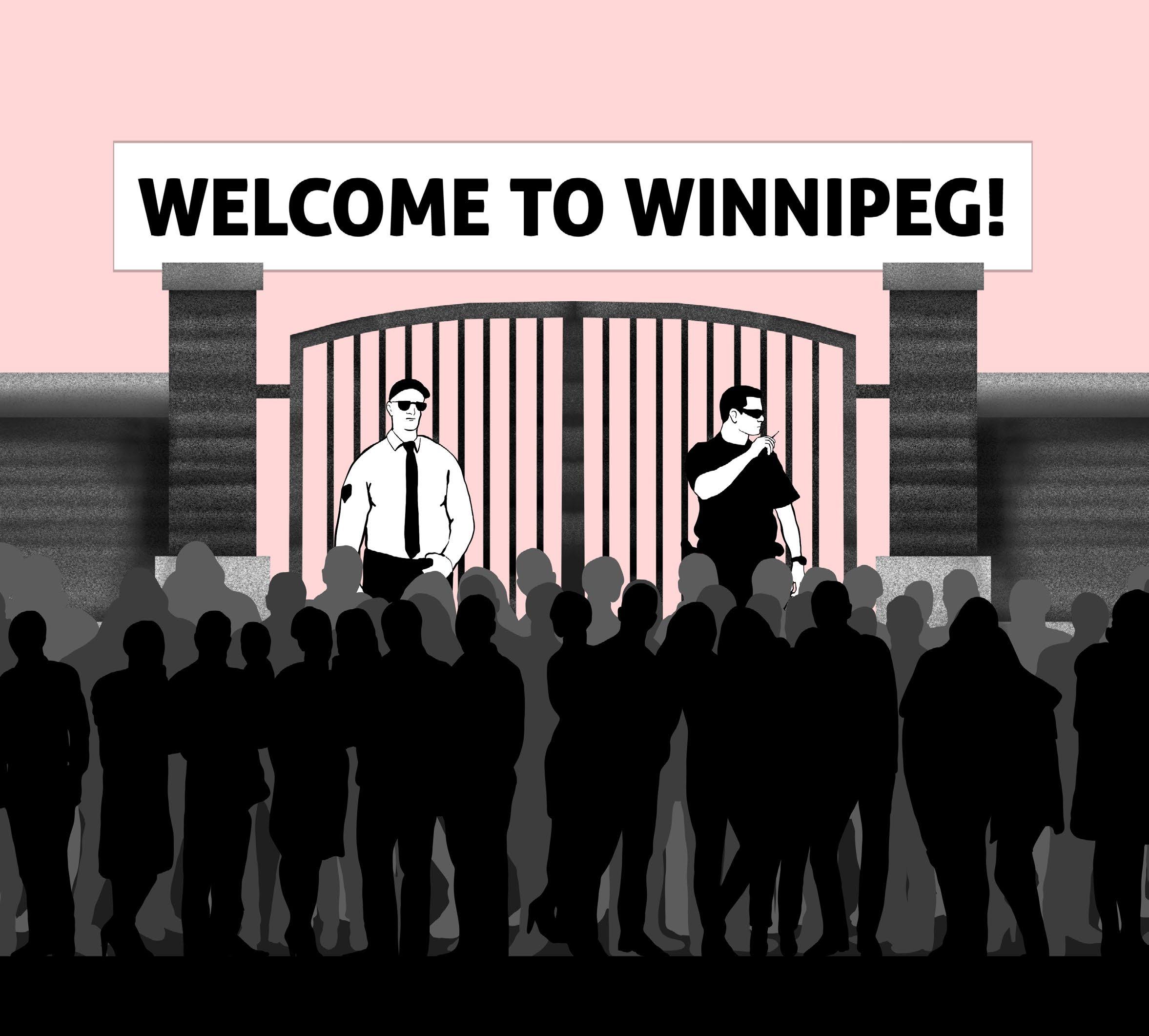
River.”
The Matheson mill was in operation for over a decade. It was in use for longer and, as a result, is objectively more historically important than the other two mills. By her own logic, Millions is suggesting that Grant’s and Louis Riel’s mills and their artifacts, built and operated by prominent Métis men, are “not particularly important to the history of the milling at Red River.”
By refusing to support historically relevant and popular name proposals and being consistently contradicted by elected officials, the WWC only undercuts its own legitimacy
However, putting this goal into practice reveals obvious blind spots in ideology and methodology in the committee’s apparatus
On March 11, committee member Erin Millions — an assistant professor in the University of Winnipeg’s history department — submitted a letter on behalf of the committee recommending that the EPC not rename Edison Park. She begins her case by arguing that “the Matheson Mill is not particularly important to the history of the milling at Red
It’s extremely irresponsible for an academic in the field of history to make such a flagrantly and demonstrably false statement in a letter advising a governing body. Watermills in the Red River Colony were largely in operation between 1829 and 1870, with only nine in existence during that time. Evidence and artifacts of a very few mills remain in Winnipeg, including Grant’s Mill on Sturgeon Creek, Louis Riel Sr.’s mill in St. Boniface, and the Matheson Mill in North Kildonan.
Grant’s mill was only in operation sporadically between late 1829 and 1832 and now operates as a museum. Riel’s mill was in operation from around 1850 until the later part of the decade, and the millstones are displayed outside of the St. Boniface Museum.
No one would make such a ridiculous argument, steeped in historical revisionism. So it provokes the question: why was the very same irrational argument made with regard to the Matheson Mill?
Millions goes on to argue that, because Métis people were heavily involved in the milling trade around the same time, the Matheson Millstones are symbolic and representative of this Indigenous history. And in the case of the Grant and Riel mills, they certainly are. However, historians like Jim Smith, president and historian of NEWHS, have long
searched censuses and historical documents and have found no evidence of Indigenous people or groups connected to the Matheson Millstones or water milling in northeast Winnipeg between 1829 and 1870.
The WWC — consisting of academics, at least one of whom specializes in history — had in excess of three years to make some relevant historical connection. But instead, it rested its case entirely on symbolism as justification for not supporting an obvious name choice, a name that was supported by 83 per cent of Winnipeggers surveyed. It’s no wonder the EPC decided to disregard the recommendation of the WWC and vote five to one in favour of the name change.
But this isn’t the first time the WWC has made an erroneous recommendation. In September, the WWC similarly sent a recommendation to the EPC not supporting the renaming of Appletree-Bridgeland Drive North Park to Emeka Nnadi Park, honouring Nigerian-Canadian and Nadi Group CEO, Emeka Nnadi. Nnadi was instrumental in the
development of the Bridgwater area, where the park is located, and over 90 per cent of those surveyed supported the name change. In a similar fashion, the EPC went on to disregard the committee’s recommendation and move ahead with the new name anyway.
By refusing to support historically relevant and popular name proposals and consistently being contradicted by elected officials, the WWC only undercuts its own legitimacy. It’s obvious that the committee needs major reform, or these issues will only be exacerbated in the future.
Winnipeg is such a diverse city, with people from so many different cultures, and it’s important that they’re all given the opportunity to be recognized and celebrated.
Because if the perspectives and histories of all backgrounds are not evenly welcome, what, really, is the point of the committee at all?
Kenny Ingram is a University of Manitoba alumnus and a student at the University of Winnipeg.


30 years later, apartheid remains on the ballot
South Africa’s upcoming presidential election a referendum on the political economy
Octavius Kahiya, volunteer
I left South Africa a few days before the general elections in 2019. My parents decided that, despite the jubilation within the country, I ought to study abroad because they felt it was the best way to secure my future.
While I hadn’t gained a full understanding of the situation in South Africa at the time, the rise of president Cyril Ramaphosa’s government was just too big to ignore and very much in all our faces.
The first time I felt this way was in church the Sunday after president Jacob Zuma’s resignation. The people in the church sang Ramaphosa’s praises, along with the song that soon became a key slogan for his campaign, “Thuma Mina.” This slogan had been derived from South African jazz legend Hugh Masekela’s song, “Thuma Mina,” which in many ways speaks of servitude.
The literal translation of “thuma mina” to English is “send me.” Nine years of Zuma’s controversial tenure as president of South Africa seemed set for a new era of prosperity under Ramaphosa, post-apartheid president Nelson Mandela’s preferred successor.
Post Apartheid Economy
There is a backstory that sets the mood for the jubilation that followed Ramaphosa’s rise to South African presidency, as well as the disappointment that has engulfed South Africans because of his first term in office. Mandela had advocated for a mixed economy opposed to nationalization, and encouraged foreign investment.
The boom that followed was massive. However, South
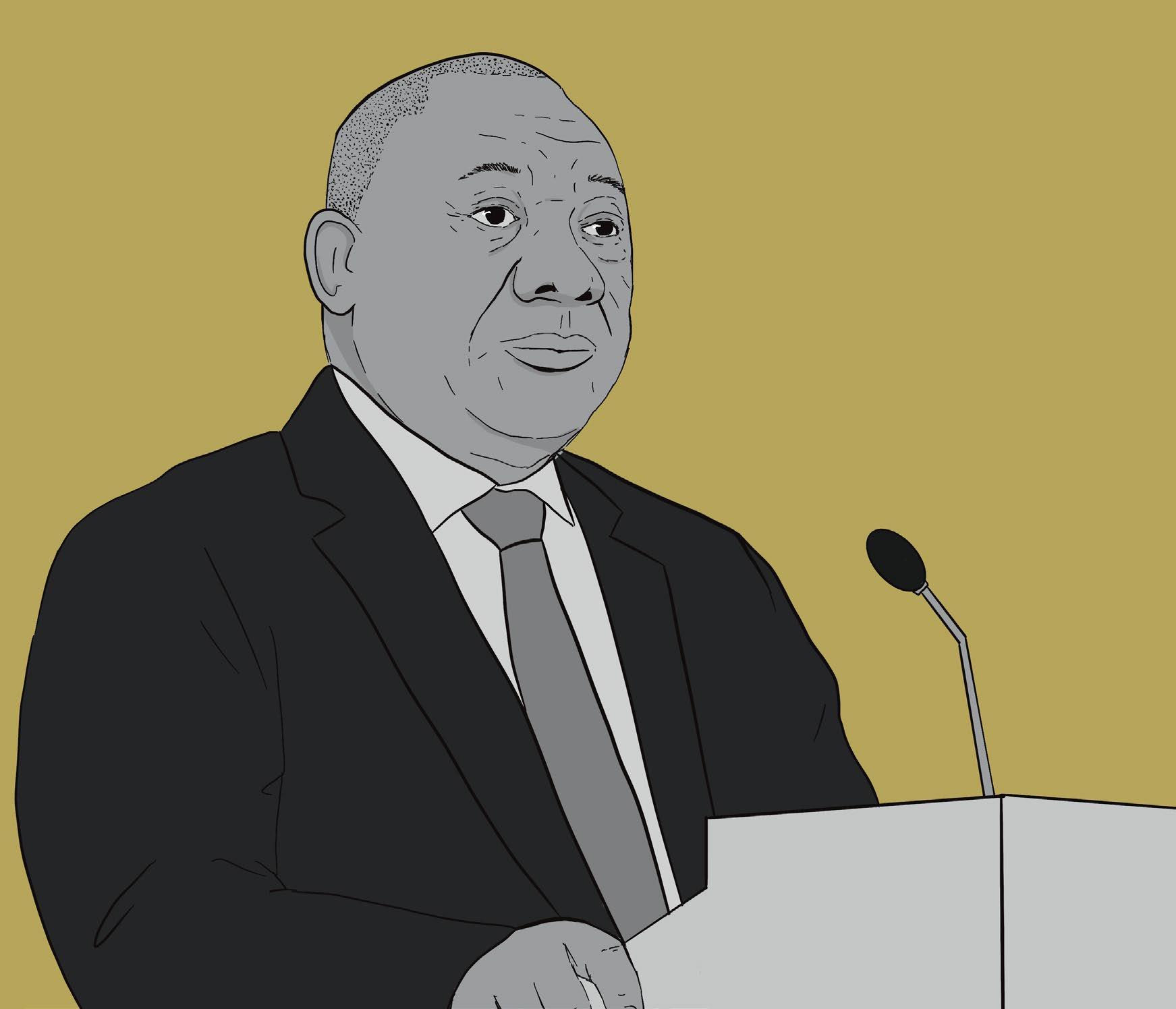
Africa remained one of the most unequal economies in the world. This world branding as an unequal economy, especially post-apartheid, triggered a political response.
In 2009, Ramaphosa’s predecessor, Zuma, was sworn in as the president of South Africa.
He and his faction of the African National Congress (ANC) had a key objective to tackle inequality. They called it Radical Economic Transformation (RET). However, with many allegations of corruption and the appointment of unpopular government ministers, Zuma’s plan ended in a resignation and a commission of inquiry into his tenure as president to investigate corruption.
This commission also led to Zuma’s arrest, owing to his failure to attend when he was summoned. However, the greatest burden that Zuma would leave for his successor isn’t the political and judicial quagmire, but rather an
tration.
Ramaphosa and the 2024 election
Apartheid South Africa’s political economy is very much on the ballot papers
energy crisis that had been passed on to Zuma by his predecessor, Thabo Mbeki, that has only worsened in recent years.
This crisis has seen planned power cuts, known as load shedding, instituted in order to avoid the South African grid collapsing. It is some of these major challenges that have posed a grave threat to Ramaphosa and his adminis-
With a stagnating economy that has only been exacerbated by these power cuts, Ramaphosa’s ANC has a long and difficult campaign trail ahead of them.
For the first time in 30 years, polls show that the ANC may not be on its way to winning a majority in parliament.
Other polls show that a growing number of South Africans no longer believe in democratic government, instead preferring a benevolent dictator if they are able to get the job done, a chilling reality during a crucial year for democracy in itself. What
is more worrying is Ramaphosa’s dismal record as president, which has gained him notoriety among his political rivals.
This failure to manage South Africa will be crucial at the ballot box as various parties have made it their mission to unseat the ANC in May 2024. In fact, the main opposition, the Democratic Alliance, has put together a coalition to make sure the ANC or the left-wing socialist Economic Freedom Fighters (EFF) do not form a majority or coalition government.
The EFF is currently the third largest party in the country. They have promised economic emancipation for South Africa’s Black majority through socialist programming and a land reform that would see land expropriated from white farmers to Black farmers.
At the end of the day, the verdict rests with the South African people. One thing is simply undeniable — 30 years afterward, apartheid South Africa’s political economy is very much on the ballot papers. Addressing bread and butter issues remains the most pressing issue of the day in a country that has already suffered a senseless tyranny prior to its independence.
The world will be watching this election as Africa’s most industrialized economy heads to the polls. As the day draws nearer, I am transported back to 2019 just before I moved to Canada. No one seems to be as excited to go and vote as they were in 2019. There is no more thuma mina.
While we do not know how everything will play out on the day, one thing is for sure — the voters will be taking the economic pain of the last couple of years to the ballot box.

As an ‘ideas museum,’ CMHR is giving us the wrong idea
Representation of Israel-Palestine conflict must show imbalance against Palestine
alison Moule, volunteerThe Canadian Museum for Human Rights (CMHR) has been criticized since before its opening in 2014. Several ethnic communities have felt that their stories were being misrepresented, under-represented or not represented at all, in the museum’s exhibits.
I arrived in Winnipeg in September, an expat from Toronto working at another museum in the city. I put off my first trip to the CMHR until my family visited, and we partook in some educational tourism. The museum, which operates as an “ideas museum” rather than an objects-based museum, is a monumental maze of textheavy panels and audio-visual material garnished with a sparse few objects installed around stony galleries.
I experienced the museum as a “greatest-hits” album of genocide, ethnic cleansing, internment camps and racism. The CMHR provides a textbook version of human rights, presenting issues that have already been accepted in the canon of important movements or tragedies, but which in their times weren’t without controversy.
On Dec. 10, 2023, my second visit to the museum, protesters gathered outside the CMHR main entrance, beginning a demonstration for the UN-designated Human Rights Day, and the 75-year anniversary of the adoption of the Universal Declaration of Human Rights.
Inside, protesters installed themselves as a temporary exhibit in the entrance hall by performing a die-in, lying on the floor for over an hour — one minute for every day since Israel’s war in Gaza began. Members of the local Palestinian community and anti-war activists delivered speeches, calling on the CMHR to recognize Palestinian human rights and take a stronger stance in the current crisis. I spoke to the crowd about my perspective both as a museum worker and as a Jew.
Canadian museums have been making strides, with varying success, toward decolonization, usually focusing on collaboration with local Indigenous communities to best represent and care for Indigenous stories and material culture.
Decolonization is a curatorial buzzword that, while well-intentioned, entails a process that cannot be realized while settler-colonialism is protected from criticism. This is why exhibit material educating the public about

the historical context for the colonial project of Zionism, and the creation of the State of Israel on the land of historic Palestine, is essential.
Palestinian-Canadians have been dissatisfied with the CMHR’s exclusion of their stories since the museum’s conception. Numerous protests have taken place outside the museum in the past, and especially since the beginning of the current war in Gaza.
Winnipeg has seen five months of consistent protesting, and a growing solidarity between marginalized groups in the city. In January, a protest for a ceasefire in Gaza moved from outside the CMHR to nearby Union Station, joining a march demanding justice for Afolabi Stephen Opaso, a Nigerian international student who was fatally shot by Winnipeg police. Pro-Palestine protesters showed their solidarity with the Black Lives Matter movement, understanding that anti-racism is essential for both causes.
The CMHR features Nelson Mandela for his leadership in the movement to end apartheid in South Africa. Mandela said, during a speech for the International Day of Solidarity with the Palestinian People, “We know too well that our freedom is incomplete without the freedom of the Palestinians.”
But the CMHR mentions Palestine once, in a small display case that tells the story of Izzeldin Abuelaish, a doctor from Gaza whose three daughters and a niece were killed when their home was shelled by an Israeli tank in 2009. The case includes Abuelaish’s curfew pass, permit and ID that were required for him to cross the Erez checkpoint to get to work at an Israeli hospital, and a stuffed toy and cellphone that belonged to his daughters.
There is also a small panel in a timeline of key events in the history of human rights, which marks the 1948 Arab-Israeli War. These mentions are brief and lacking crucial
context, but representatives from the museum have said they are committed to working with the local Palestinian community to include more of their stories and perspective in future exhibits and events.
In a 2016 book chapter, CMHR research-curators Emily Grafton and Julia Peristerakis write that much criticism of the museum can be explained by differing expectations of the functions of the museum. The public entertains certain ideas about the role that the museum can play in past and ongoing issues of human rights, but are holding the museum at an unrealistic standard. According to Grafton and Peristerakis, what the CMHR can do is “present balanced views on human rights, educate the public, and elicit dialogue,” but it cannot, however, “adjudicate on violations of human rights.”
The CMHR’s ideas-based exhibits, and the ideas they communicate through social media posts, do attempt to present a balanced view of the
Israel-Palestine conflict. But I believe that the view is too balanced for a heavily unbalanced conflict. It is inevitable that some groups will be displeased no matter how the conflict is presented.
This cautiously neutral approach gives the public the idea that some conflicts are simply too complicated to understand, or that, contrary to the museum’s genocide exhibit titled “Breaking the Silence,” it is best to stay silent if an issue is too controversial.
What is the purpose of a human rights museum if it cannot take a clear stance on human rights violations? Wait to install a memorial? Create a retrospective exhibit encouraging viewers to prevent such a tragedy from occurring again? If so, the CMHR is not teaching us what we need to learn.
Alison Moule is a museum worker and a member of Independent Jewish Voices Canada and United Jewish People’s Order
Diversions
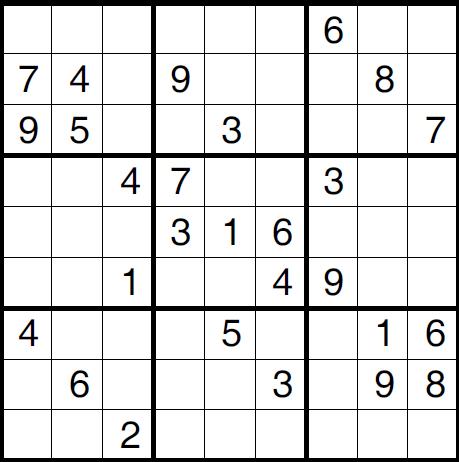
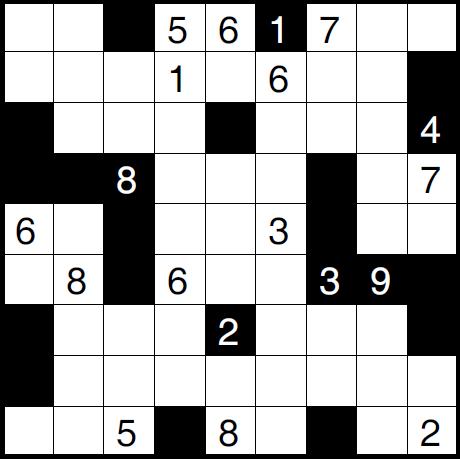
To complete Sudoku, fill the board by entering numbers 1 to 9 such that each row, column, and 3x3 box contains every number uniquely. In Straights, like Sudoku, no single number 1 to 9 can repeat in any row or column. But rows and columns are divided by black squares into compartments. Each compartment must form a “straight.” A straight is a set of numbers with no gaps but it can be in any order, eg [7,6,9,8]. Clues in black cells remove that number as an option in that row and column, and are not part of any straight. Glance at the solution to see how “straights” are formed.




13 by 45 orthogonal maze

Surrender to the story of Rise, Red River
MMIWG2S reclaim sovereignty in Tara Beagan’s powerful play
alison holliday, staffWhen Calgary-based playwright Tara Beagan was first approached by artistic director of Prairie Theatre Exchange (PTE), Thomas Morgan Jones, to write a play about climate change, she found herself struck by the image of a woman, alone and trawling a dried-up river.
“That [image] came to me so strong I knew that I did have the play in me,” Beagan said.
Inspired by the community work of Drag the Red, and the interconnectedness of climate change caused displacement and Missing and Murdered Indigenous Women and Girls and Two-Spirited Peoples (MMIWG2S), Beagan started to craft the story of Rise, Red River
Rise, Red River is a brutally beautiful co-production between Article 11, PTE and Théâtre Cercle Molière.
The story, performed in multiple languages, follows the character of She/Elle, portrayed by Tracey Nepinak, as she walks up and down the dried-up Red River, trawling
hooks attached to her pack, repeating the stories of stolen people while she searches for her own story.
Followed by Ancestor, portrayed by Marsha Knight, Elle encounters All Other Women, portrayed by the Caleigh Crow, who, through telling their stories, help Elle find her own.
Beagan was the playwright in residence at PTE in 2020, where she started writing about Treaty One despite not physically being in Winnipeg and found herself having “logged a lot of kilometres walking and walking,” much like Elle herself. The story revealed itself to her on these walks.
“I was discovering it as Elle discovered it,” Beagan said.
Beagan spoke about the importance of staying open during the creative process and the fluidity of it.
“I don’t always intellectually choose things, sometimes they just arrive and I go, ‘that’s right.’”
Only once she finds herself stuck in the process does Beagan goes back to “do the
math” of playwriting.
In the play, each of the women speak a different language. Elle speaks in English to All Other Women, who replies in French, and both of them innately understand the other.
Ancestor watches on, somehow unable to directly interact with the other characters, and speaking Anishinaabemowin in voice over. Beagan herself is only fluent in English, yet when writing her second draft of the play she “started to feel like English was just too limiting.”
Drawing from both the Franco-Manitoban community and the knowledge of cultures that existed on Treaty One territory before colonization, Beagan added French and Anishinaabemowin to the play.
“We kind of needed those languages to come forward in order to, I think, really feel the music of the land,” she explained.
With multiple languages, video projections and an impressive set, Beagan celebrates the show as a huge dis-
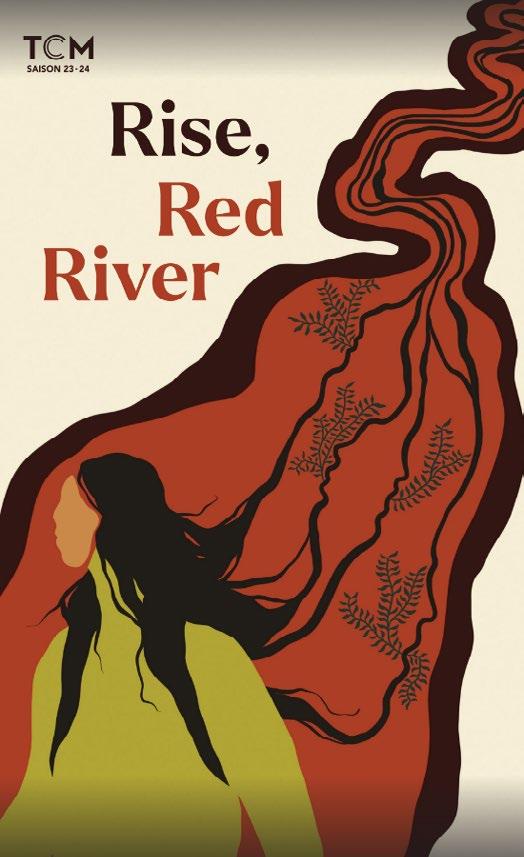
play of collaboration.
Andy Moro, the other half of Article 11 alongside Beagan, came up with the idea of using alleyway staging as a way to make the audience “feel accountable to each other and to the women onstage.”
The alleyway staging emphasizes the set, almost making the structure itself a character of the show. The platform, Beagan revealed, is simultaneously a zoomed-in and zoomed-out topographical outline of the Red River,
St. John’s serenades the masses
with the risers it is placed on emulating the bridges across Winnipeg.
When designing the set, both Moro and Beagan had in mind the treatment of the physical remains and narratives of MMIWG2S within the justice systems.
“The way that the justice system treats our stolen people is so inhumane, and we wanted to reclaim that,” Beagan said.
“We wanted to say — here is a slab of the earth and on top of it we’re going to put powerful women who are taking back their narratives.”
Beagan hopes anyone watching the show will be able to “surrender to the telling” and come away asking “where does love live inside of them and how can we regard people that we don’t know with more love?”
Rise, Red River runs at Théâtre Cercle Molière on 340 Provencher Blvd until March 23. Tickets are available at www.cerclemoliere.com at multiple pay-what-you-can rates.
St. John’s college second annual ensemble competition to take place March 22
Kelsey Chin, staff
The second annual St. John’s College Ensemble Competition is underway for the Desautels faculty of music, an event that will see students from all disciplines within the faculty come together to perform and compete against their peers on March 22 at St. John’s College Chapel.
Laura Loewen, associate dean of undergraduate programs at the faculty of music and one of the organizers behind the competition, said students are already part of different ensembles within the faculty of music. The competition aims to celebrate that.
Preliminary rounds were held on March 2, with the competition divided into three categories that contestants could compete in: instrumental, singer with instrumental and vocal ensemble.
Three faculty members chose one winner from each category to play in the final round taking place on March 22 for the final prize of $300, to be split evenly amongst the members of the winning group.
This year, the preliminary
round for the ensemble competition was a closed event, but Loewen expressed interest in having it open in the future. After having another competition be an open event, Loewen said this format takes some pressure off of competitors and encourages them to enjoy the experience more.
“I think for next year we’re going to organize that with the prelims, so the whole thing is more of a celebration, not just the finals.”
The competition, which is a counterpart to the annual St. John’s art competition, now in its 12th run, started when retired Desautels faculty member, Kurt Markstrom, had the idea to add a musical aspect to the St John’s college art competition.
As a fellow of St. John’s, Loewen said it was important for Markstrom to find a way to unite his two spheres of involvement, St. Johns and Desautels, which influenced the creation of the ensemble competition.
Henry Kelsey, pianist from the Dafoe Piano Quartet, one of the winning teams from the preliminary round, said the
quartet formed their group just this year but were glad to hear of the opportunity to perform for the competition.
Kelsey said the group will be performing two songs in contrasting styles.
“For us, a lot of the motivation [for our song choice] was not only the beauty of the music, but showcasing all of the instruments and our capabilities as an ensemble.”
The two other groups going to the final are Four/Four and The Matriarchy.
When asked what she and the other judges were looking for from contestants in the preliminary round, Loewen said, “for me, it’s always about communication and telling stories […] and the beauty of making music with other people, and all of these groups had just extraordinary ensembles.”
For the final round of the competition, audience members will be deciding who takes home the crown. Loewen said she hopes the crowd is “nice and rowdy and cheering for all the groups.”
Winners of the art competition will also be announced
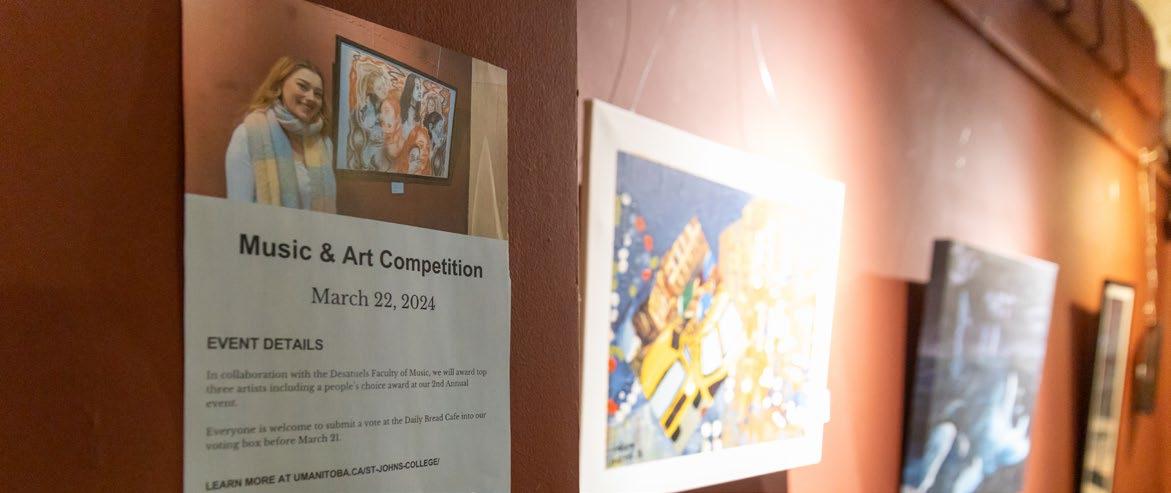
following the music portion that afternoon.
Having an audience is something Kelsey said he is looking forward to.
“A panel is lovely, but it feels like a very personal and intimate experience in the quartet when we’re playing for a small number of people,” he said.
“And when you open that up, it encourages us to make more bold decisions and to embrace the passionate moments.”
“It was really wonderful last [time],” said Loewen, explaining that previously, large numbers of parents, music students and art students attended the event due to the conjoined art competition. A love for art and supporting artists was present.
“Being a university student is super stressful. Being a music student is super stressful […] and it’s easy to get caught up in the work that we have to do every day,” said Loewen.
“This particular competition, it seems like people can remember why they went into this and how much they love making music with each other, and there’s really nothing better than that.”
Attendees are welcome to come and watch the final round of the competition March 22 in St. John’s College Chapel, which will take place from 3:30 to 4:30 p.m., with a reception at the Daily Bread Café following from 4:30 to 5:30 p.m.
Women at War and its shortcomings
Questionable content and lack of international scope drags the exhibit down
Braden Bristow, staffRunning from Feb. 29 to Apr. 27 in the University of Manitoba’s school of art gallery, Women at War is an exhibit featuring the artistic works of Ukrainian women. A majority of the exhibit focuses on the experiences of women in recent Russian invasions of Ukraine.
Women at War features stories that can be compelling. However, it suffers in two major areas.
First, the content of the exhibit fails to advance women’s agency, or meaningfully comment on the gendered elements of war.
Second, there is a lack of intersectionality and understanding in the exhibit, which exclusively focuses on the experiences of white Ukrainian civilian women, ignoring the experiences of Ukrainians of colour.
The exhibit portrays women as victims. Numerous pieces depict women simply as victims of male violence, with little agency in the greater social context. While the exhibit features numerous stories of women facing hardship in Ukraine, those perspectives mainly show Ukrainian women as being without agency.
In the exhibit, women either serve as passive supporters of male combatants, observers of conflict, victims of displacement or victims of Russian violence. “Max in the Army” and “Untitled 1” through “3” by Lesia Khomenko, specifically centre men with agency, rather than women, on both the Ukrainian and Russian sides.
Some of the most extreme examples depicting women’s lack of agency are the pieces “Lviv Diary” by Vlada Ralko and the series of drawings from “Mother Srebrenica Mother Donbas” by Dana Kavelina.
“Lviv Diary” depicts numerous vaguely sexual and violent images. One image depicts a nude feminine figure with her hands tied behind her back and her face obscured in darkness.
Another image shows a figure with a bloody womb with
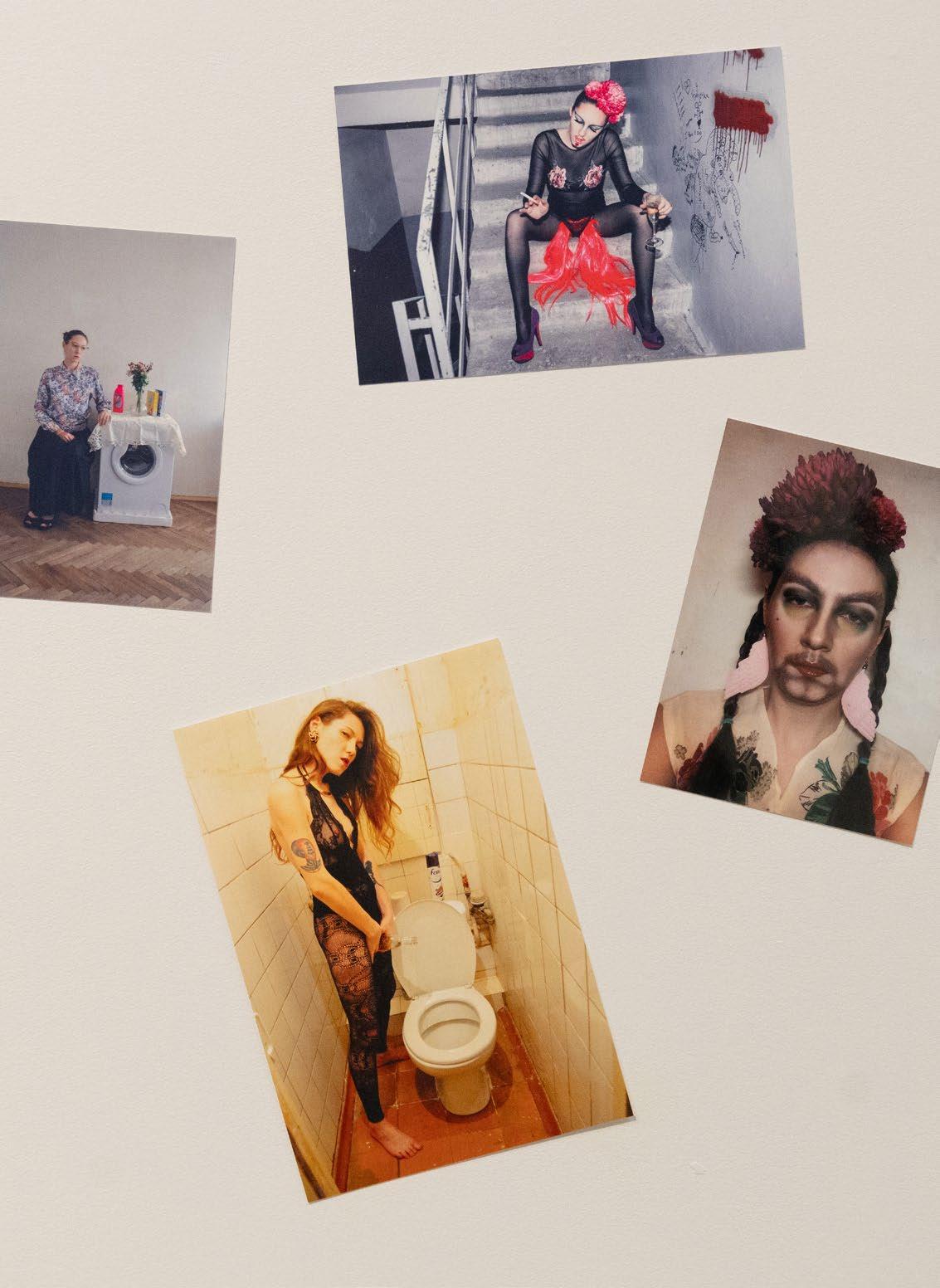
a hammer and sickle, a famously communist symbol, overlaid atop each other. Considering Russia has not been communist for over 30 years, it is unclear what the purpose of the hammer and sickle is.
Numerous drawings in the “Mother Srebrenica Mother Donbas” series depict surreal scenes of sexual assaults. In each of the drawings in the series women are depicted exclusively as victims with no ability to speak out or retaliate.
While the exhibit is titled Women at War, it would be more appropriate to say that the exhibit regards women as victims of war.
One set of images which I found particularly bizarre was provided by Kateryna Yermolaeva. The pieces, simply referred to as “Photo 1” through “4,” depict four images of the artist amid an identity crisis caused by the conflict in Ukraine.
The artist states that she lost herself “as an artist” which led to her experimentation with identity, particularly gender expression and nonbinary depictions of gender.
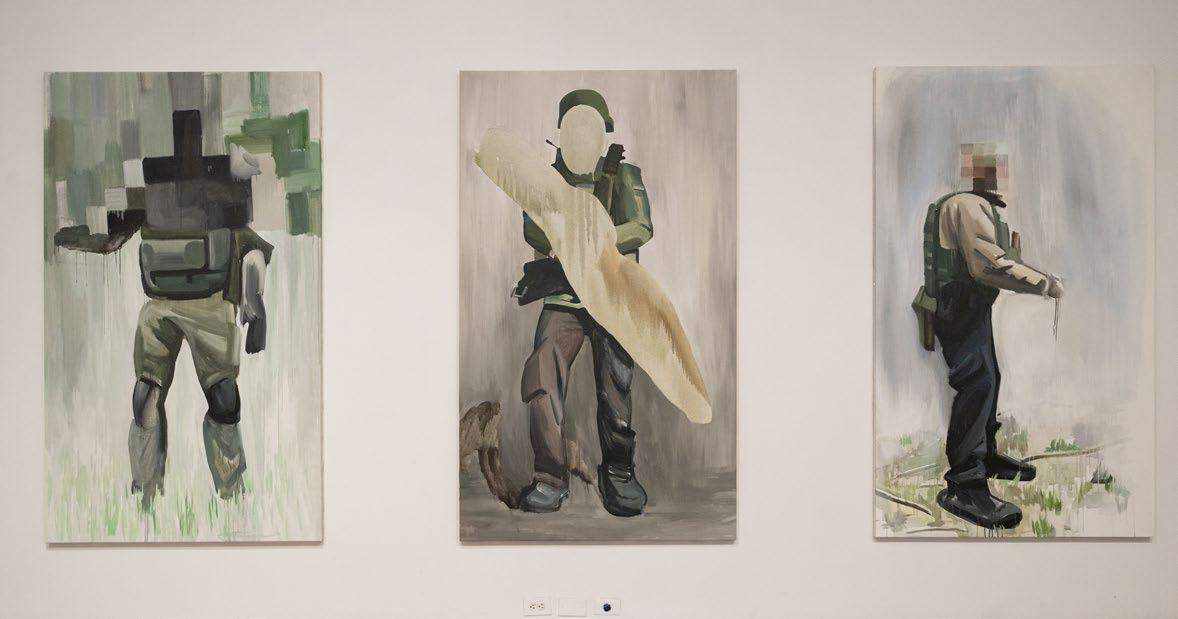
While each individual has a different journey with gender identity, to depict androgyny and experimentation with gender identity as the result of war is problematic, reducing something deeply personal and potentially powerful to simply being the result of crisis.
The previous pieces fail to meaningfully advance women’s agency while “Photos” fails to comment on, and borderline insults, queer people.
The exhibit is not outwarly identified as feminist. But, a surface glance at the exhibit could lead viewers to assume that there would be feminist influence or sentiment. However, in terms of feminism, these pieces leave a great deal of intersectionality to be desired.
Not only are women depicted as powerless in a social sense, but even in their personal lives, their gender identity is not their own.
Any mention of military service is also exclusively focused on men, but as of January 2024, there were at least 45,487 women serving in the Ukrainian military.
If the exhibit was about women at war, then it ought to have included the perspectives of those service members, or at least depictions of those service members.
This is especially important considering that women in the Ukrainian military have experienced multiple instances of discriminatory treatment. One particularly egregious event involved an alleg-
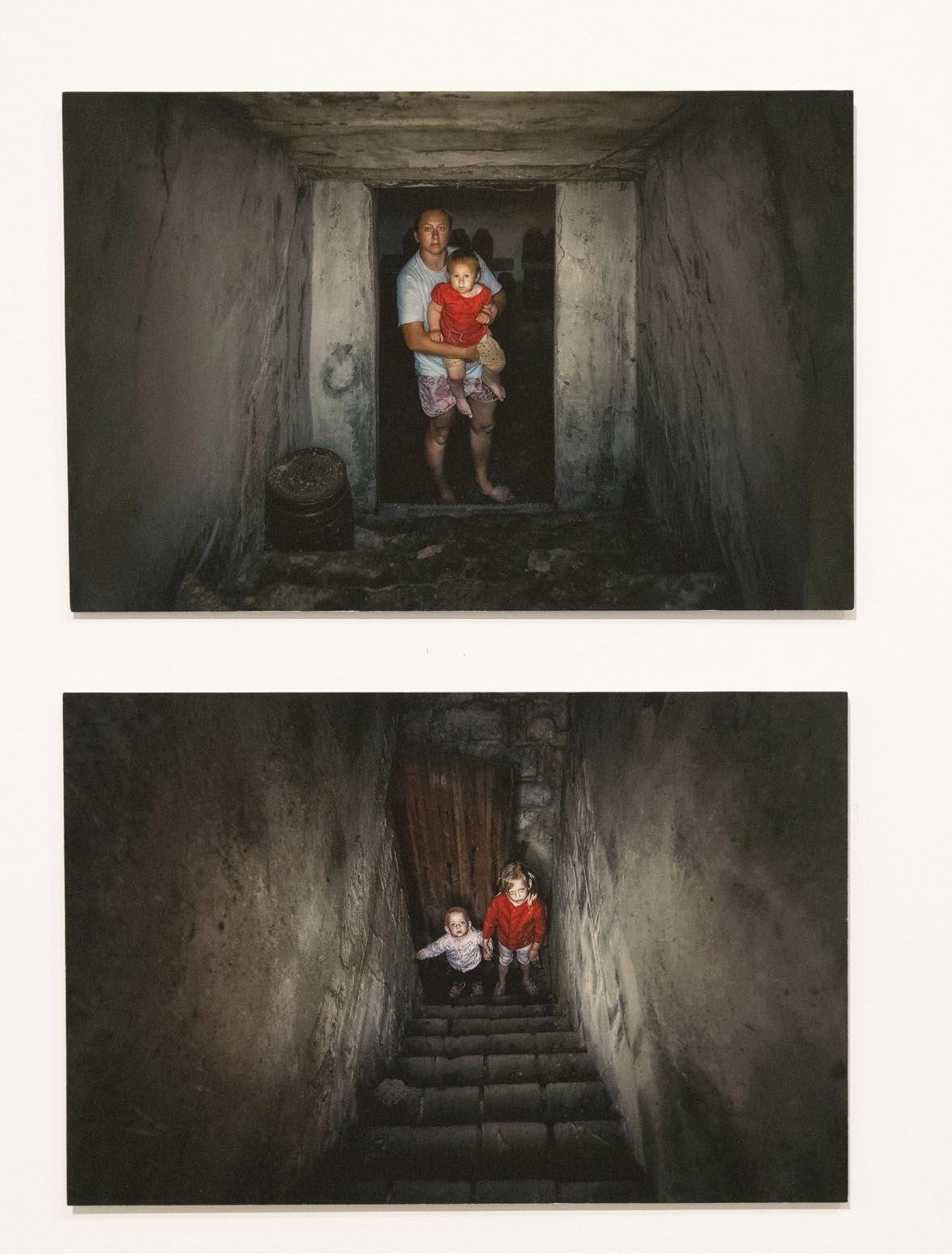
ation against a commander who sexually assaulted his female subordinates and threatened them with the conscription of their husbands to the front lines if they refused.
The exhibit focuses on some important perspectives, but as it focuses on white civilian women, there are numerous narratives that are excluded, including those of Ukrainians of colour.
It is alarming that Ukrainians of colour are under-represented in this exhibit, especially considering the multiple accounts of racism Black Ukrainian refugees experienced during the start of the Russian invasion.
In an example directly related to the Russian invasion, Russian women have engaged in protests demanding an end to the war, despite these protests being illegal under Russian law. Including a perspective such as this would go a great length in showing women’s agency.
This angle would show that the Russian invasion of Ukraine is being opposed in ways outside of violence or combat. This could also show that nations are not monolithic groups, something that the exhibit needs to expand on.
Inside the New People’s Army, a 2018 documentary by Redfish, has a particularly engaging narrative regarding women at war. This piece does an excellent job of focusing on women’s voices during periods of armed conflict.
The documentary depicts female guerillas within the
New People’s Army (NPA), a communist rebel group in the Philippines. One woman within the NPA reveals that she was originally a laborer prior to joining, but uses what she has as an individual to assist where she can.
The role of women during times of conflict is much more nuanced than solely being victims. Women both oppose and participate in armed conflict. Their experiences with war will differ given intersections in their lives, but nevertheless deserve to be spoken about and represented.
Women at War fails to depict these more complex realities.
My intent is not to manufacture consent for war as an equal opportunity arrangement. I do not want anyone to join the army, never mind women.
Rather, I think it is important to depict how women exercise agency in social and historical contexts.
However, since the exhibit fails to include any narrative outside of victimhood, these women’s agency is reduced to commenting on their displacement, experience with violence and personal crises.
Believe it or not, women have a much greater role in our society than enduring the actions of men.
U of M tennis club looks to serve new experiences
Learn more about why you might want to join the tennis club
Quinn Mayhew, staffWhile being a student at the U of M can be difficult and stressful, the University of Manitoba Tennis Club (UMTC) can improve students’ and other members of the community’s health and well-being through tennis.
UMTC offers a variety of programs for all walks of life — whether it’s recreational or competitive programs, UMTC offers it all.
The club plays during the evenings at Max Bell Centre on campus, and it is split into two groups. But both the recreational and competitive sides of the club are places in which people can foster friendships and get some exercise.
Although, as the name suggests, the competitive side is for those wishing to play more intensely.
The club spans year-round and hosts tryouts at the beginning of each term.
The president of the UMTC, Craig Hillier, put a strong emphasis on the importance of inclusion within the club. He said “equity, diversity and inclusion” are all big parts of the tennis club. “Our club is for anybody,” he added. “I want everybody [to] feel like they belong.”
The tennis club’s competitive side is looking to expand its roster by establishing a women’s team. Ideally, it is looking for players with a rating of 3.0 to 3.5.
Recently, the men’s team competed at the yearly Prairie Invitational University Tennis tournament in Calgary, Alta.
Hillier went on to note the importance of growing the game in Manitoba. “I want to be able to provide students with an opportunity to have a student-athlete experience,” he said. “We lose a lot of those tennis athletes to other universities.”
“My goal is to keep the talent within the province, at the university level,” he said. Hillier specifically wants to provide youth an opportunity to develop their skills in Manitoba instead of switching provinces to play varsity tennis at another university.
Hillier’s love for tennis is at the heart of the club. He attributes his deep affection for the sport to the many wonderful experiences playing gave him.
“I want to try and share tennis with as many individuals as I can,” Hillier said, “so that they can

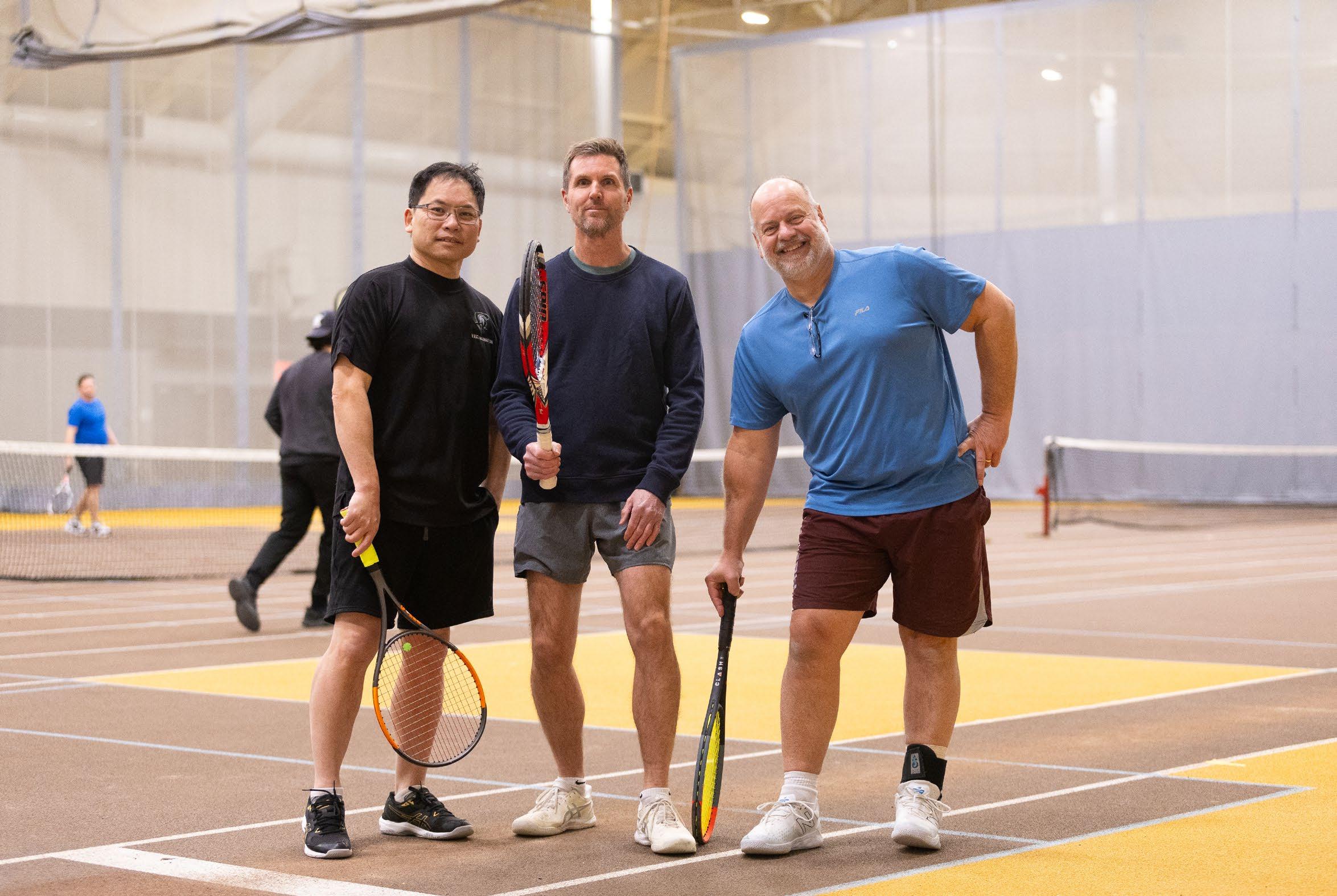
“I want to make everyone feel like they belong”
— Craig Hillier, U of M tennis club president
reap the rewards and the benefits, the health and well-being that is associated with it.” Students and alumni want-
ing to join should note that they are required to pay an annual fee in order to join the club. Mostly, the funds go toward maintaining the equipment, although it nets new players a T-shirt as well.
As Hillier looks to grow and expand the club and the game of tennis, university students, alumni and young athletes alike have the opportunity to develop their skills right here at home. Whether it’s recreational or competitive, UMTC offers opportunities for everyone.
University of Manitoba stu-
dents, alumni and those planning to attend the U of M who are interested in joining the club can reach out to Craig Hillier via email at umtennis@gmail.com to receive further information about how to get involved.
Bisons bag bronze at U-Sports championships
Number one seeded herd lost tight semifinal, rebounded in bronze medal match
Joshua Brandt, staffThe U of M women’s volleyball team played for the chance to win a national title this past weekend at the 2024 U-Sports championship, hosted by McMaster University. Ranked as the number one team in the eight-team tournament and coming off a CanWest championship win, the Bisons seemed poised to capture its first national championship since the 201314 season.
Quarterfinal match
In the one-versus-eight quarterfinal matchup, the Bisons faced off against the Saint Mary’s University Huskies.
The ranking discrepancy showed, as the Bisons dispatched the Huskies with ease, nabbing a 3-1 victory.
Light Uchechukwu performed especially well for the herd, smashing home 19 kills to go along with seven digs.
Katreena Bentley shared the ball effectively, dishing out 41 marvellous assists as well.
Eve Catojo hit an uber-efficient .438 from the middle, accumulating seven big kills in the process. Catojo even chipped in with a couple of assists, too.
With the win, the herd were set to face a fellow CanWest squad in the semifinal — the fourth-ranked University of Alberta (U of A) Pandas.
Semifinal match
With a chance to play in the gold-medal match, both the herd and the Pandas came out with lots of energy.
The match was a back-andforth, heavy-weight clash, as neither school could wrestle away momentum from the other for very long.
U of A took the first set 25-21, but the herd thundered back in the second, taking it 25-21 to even the match up at one set a piece.
Nevertheless, in the third set, the pesky Pandas quelled the U of M’s rally, restoring its one-set lead with a convincing 25-18 win.
With its back against the wall, the herd triumphed in the fourth set 25-22 to even the match up at two sets a piece and force a deciding fifth set.


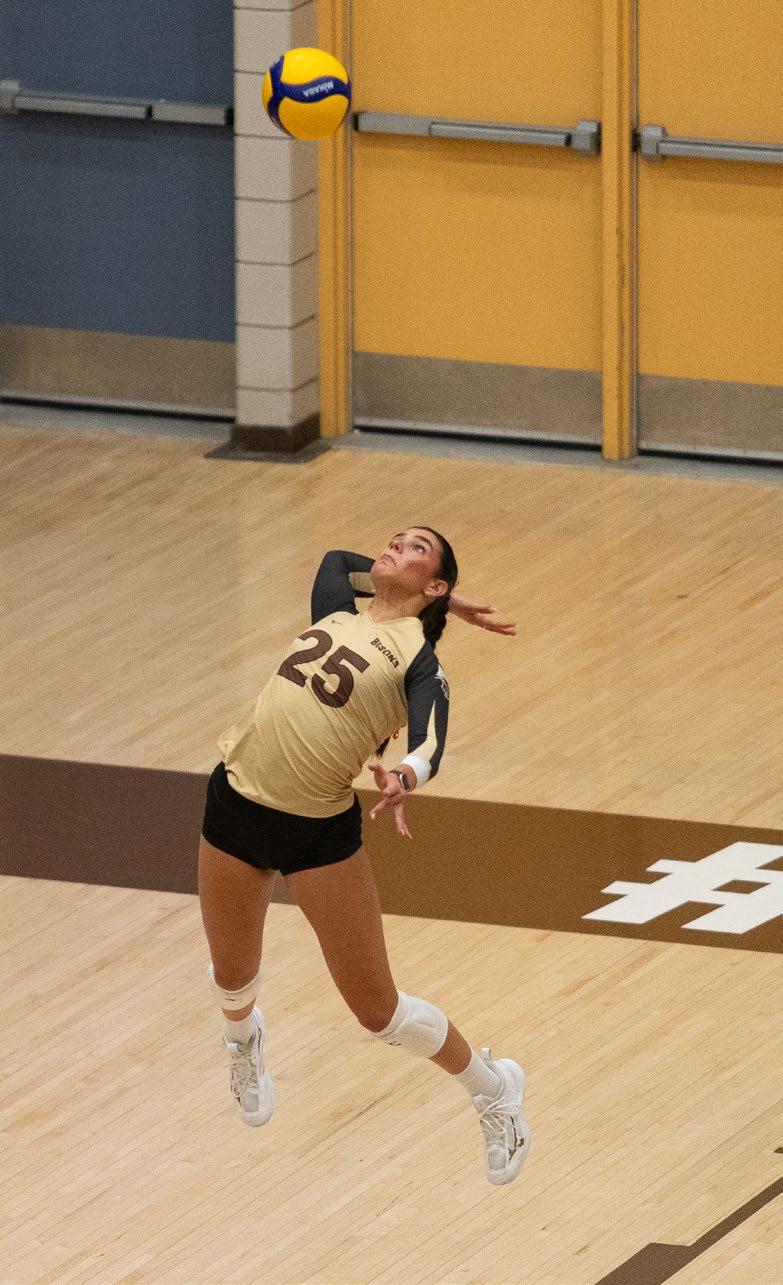
error, sending it out the back, ceding both a point and the match to the Pandas.
Surinx was the U of M’s most prolific attacker, registering 20 kills.
Manitoba throttled the Axewomen en route to winning a U-Sports bronze medal in straight sets
The fifth set came down to the wire. After a U of A service error, the herd went up 16-15, needing to win by two points to advance.
Alberta managed to
side-out, however, as it fed U-Sports Rookie of the Year Abby Guezen. It was her 33rd kill of the night. Alberta then notched a fortunate ace, which seemed to have eyes as it hit Raya Surinx in the back corner of the court.
With the score 17-16 in favour of the Pandas, Ella Gray took a valiant swing, looking to level the score once again. However, she made an
Gray chipped in with 11 kills as well.
Bronze medal match
Looking to rebound from its disappointing semifinal loss, the herd matched up against the Acadia University Axewomen in the third-place match.
The match was never close.
The herd won the first set 25-18, the second, 25-13, and the third, 25-17. Manitoba throttled the Axewomen en route to winning a U-Sports bronze medal in straight sets, 3-0.
Several Bisons had notable performances.
Uchechukwu compiled 11 kills in her last game with the Bisons. Andi Almonte registered a trio of aces, and Brenna Bedosky’s arms proved very stiff, as she stymied a couple of Axewomen swings, picking up two blocks.
Overall, despite missing out on a U-Sports national championship, the Bisons had a
remarkably successful season, finishing third in the country. The team compiled a record of 27 wins and five losses, and, of course, won the 2024 CanWest championships for the first time in the school’s history. Expect the herd to swing for ever higher heights in the 2024-25 season, as a swath of key players have eligibility remaining.

